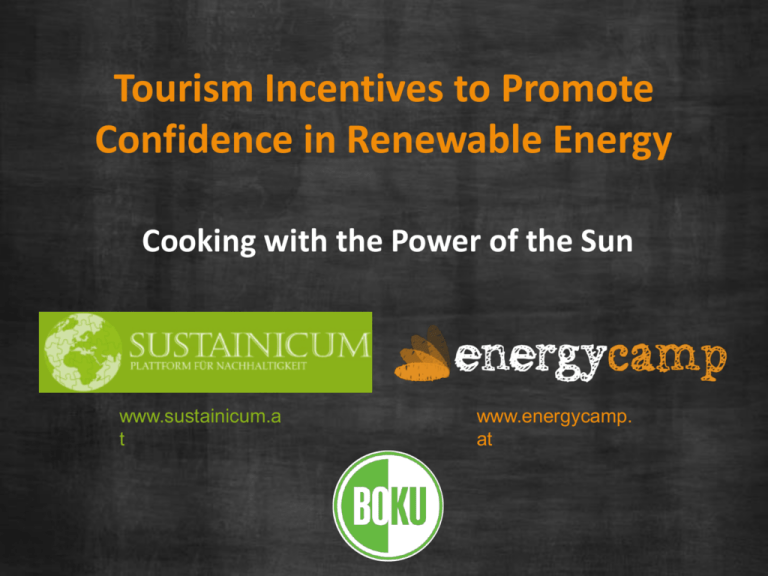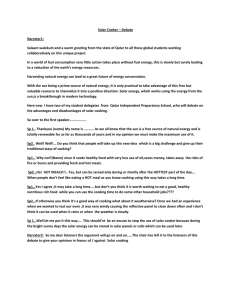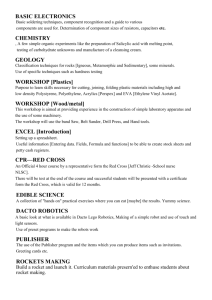
Tourism Incentives to Promote
Confidence in Renewable Energy
Cooking with the Power of the Sun
www.sustainicum.a
t
www.energycamp.
at
The use of this text and all accompanying illustrations is subject to the restrictions of the Creative Commons license
“by-nc-nd – Attribution-Noncommercial-Noderivatives“ supplemented by the information below.
For more information on the Creative Commons go to: http://creativecommons.org
Permission rights were obtained directly from image creators.
All rights reserved by the Institute of Landscape Development, Recreation, and Conservation Planning of the University
of Natural Resources and Life Sciences, which must be cited as follows:
“Source of data: Institut für Landschaftsentwicklung, Erholungs- und Naturschutzplanung, BOKU Wien“
This data may not be used in applications or publications that support or incite criminal, illegal,
racist, discriminatory, libelous, pornographic, sexist, or homophobic activities.
“Tell me, and I will forget. Show me, and I will remember.
Let me do it, and I will understand.” Confucius
renewable
energy
solar cooking
energy
regions
energy camp
Sources (clockwise):
Energy-Camp
http://www.eee-info.net/cms/
http://www.flickr.com/photos/50811886@N00 & http://images.cdn.fotopedia.com/flickr-151969001-original.jpg
Energy Tourism &
Tourism Programs
Opportunities for
Active Knowledge Transfer
Energy Tourism
Daytrips or longer excursions to natural areas, regions,
parks or tourism facilities that specialize in renewable and
alternative energy production, utilization, or adaptation for
daily use. The fundamental principles of energy tourism
are the exchange of knowledge and experience-oriented
activity.
experienceoriented
specialized
Energy Tourism for Professionals
• Target Groups: tourism for experts –
community representatives, business
executives, university faculty
• Destinations: Alternative energy
generation systems, autonomousenergy regions, examples of bestpractice
• Purpose: Technical innovation,
exchange of information and knowhow
• Knowledge Transfer: cognitive
dimension, professional
communication seminars, tours,
Source:
http://www.enertour.bz.it/de
Experience-Oriented Energy Tourism
• Target Groups: Vacationers,
families, children, and youth
groups
• Destinations: Nature trails,
exhibitions, and learning-by-doing
programs about alternative energy
• Purpose: Relaxation, recreation,
fun, leisure-time learning
• Knowledge Transfer: Affective and
kinesthetic dimension, emotional
communication, fun-oriented
design
• Duration: Trips of one day up to
Source: www.welios.at
Energy Camp:
An example of experience-oriented ET
Day camp or multiple-day camp for
children and youth, as well as teambuilding camp for adults
Identifies practical ways to counteract
climate change effectively
Provides experiences that stimulate
thought and action – imparting a “do-itdifferently” mentality
Presentation and application of technical
innovations
Develops skills for the sustainable design
of tomorrow
Source: Energy -Camp
Experiential Learning
Learning through discovery
an active, self-guided, and constructive
process
Action and reflection
deepen lessons by spending time
reflecting after each phase of learning
Accessibility
links to social concerns – opportunities to
co-create
Forward-looking outlook
positive and optimistic approach to social
development
Source: Energy -Camp
Energy Camp Activities
Organization
sleeping tents for males and females
self-sufficiency
Four different groups in rotation
E-cooking -> supplies the camp with
food – using solar cooking methods
E-nature -> studies the energy region
and explores land-use applications to
generate energy
E-ntertainment -> puts on (evening)
entertainment programs, including
“showtime” with the participation of
campers
E-xperiment -> researches and
experiments with the mechanics of
producing solar, wind, and hydro energy.
Source: Energy -Camp
Solar Cooking: The Concept
Solar cooking is based on using
sunlight to generate heat for the
purpose of cooking food.
Devices
Archimedes, 212 v.C.
Solar hot dog stand, USA 1940
Rice cooker, France 1882
Source: http://www.buch-der-synergie.de/c_neu_html/c_04_01_sonne_geschichte_1.htm Last visit: 04.10.2012
Modern Solar Cookers
Box cooker (solar
oven)
Source: http://www.lazola.de
Last visit: 04.10.2012
Parabolic cooker
Source: Energy-Camp
Panel
cooker
Source:
http://solarcooking.wikia.com
Last visit: 04.10.2012
The Physics of Solar Cooking
Collection – Concentration –
Storage
Collection – When rays of sun hit a black
surface, heat is produced
Concentration – Reflective materials (such
as mirrors) and convex lenses (such as
magnifying glasses) are used to redirect
and concentrate sunlight
Storage – The insulating properties of
glass and other thermal materials are used
to store the generated heat.
Converting Light into Heat
– Black surfaces soak up rays of sunlight that
strike them – they do not reflect sunlight like
white surfaces
– Photons (light particles) are a form of energy
that causes the atoms of black materials to
vibrate, which in turn raises the temperature
of black objects
– Black masses absorb visible light (short
wave), which is converted into heat radiation
(long wave) and re-emitted as invisible
infrared radiation.
Source: http://www.webgeo.de/k_304/ Letzter Zugriff 02.10.2012
Collecting and
Concentrating Sunlight
– Mirrored and polished metal surfaces reflect
and “redirect” rays of sunlight.
reflective surface
rays of sunlight
absorbent surface
Source: original drawing
– Parabolic mirrors reflect incidental waves
(rays of sunlight) and concentrate them on a
single central spot (focal point).
rays of sunlight
focal point
parabolic mirror
Source: original drawing
Storing Heat: The Greenhouse Effect
– A gas-filled (air, argon, etc.) or vacuum-sealed
material blocks the flow of thermal energy
– Insulating glass lets in short-wave radiation,
retains thermal radiation (heat)
solar radiation
black surface
insulating
glass
Source: Original diagram
thermal radiation
What types of solar cookers
are there?
I. Box Cookers
Work like ovens
Utilize the Greenhouse Effect
A pane of glass admits sunlight into a
box with a black interior. Sunlight is
converted into heat. Temperatures rise
inside the box.
Cooking containers should also be black
in order to best utilize the conversion
effect
Yields lower amounts of power
compared to parabolic cookers
Pre-heating is beneficial
Well-suited to foods with longer cooking
times, such as vegetables, rice, grains,
bread, and cakes
Source:
http://www.solargourmet.de
Last visit: 09.10.2012
II. Concentration Cookers
Works like a stove top
Focuses (concentrates) sunlight
into a single point
Immediately reaches cooking
temperatures (needs no
preheating)
Generally produces higher
amounts of power than box
cookers
Requires black cookware
Source: http://www.sun-and-ice.de
Last visit: 09.10.2012
Parabolic Cooker – “The Big One”
Resembles a satellite dish in
appearance
High-quality mirror, usually made
of polished aluminum sheeting
Sunlight is focused and
concentrated on a focal point
(cooking surface)
Must be realigned to the path of
the sun (approx. every 30 Minutes)
Can reach temperatures up to
200° C
Useful for cooking processes that
require more energy, such as
Source: http://www.sun-and-ice.de
Last visit: 12.12. 2012
Scheffler Cooker – the “Powerhouse”
Shape is similar to a parabolic
cooker
Having the focal point outside of the
mirror enables cooking to take place
at a fixed position
Exact and automatic alignment to
the sun (using an electric motor)
Large reflective surfaces (up to 20
m2 )
Very powerful and efficient
Produces temperatures up to several
hundred degrees
Simple to use
Non-mobile
High cost
Source: http://www.solarebruecke.org/
Last visit: 09.10.2012
Panel Cookers – the “Basic”
Cooking pot is positioned inside or in front of
a reflector
Not very efficient – reaches maximum
temperatures of about 120 °C
Very simple designs
Easy to build yourself
Requires intense sunlight
Source: http://solarcooking.wikia.com
Last visit: 04.10.2012
Practical Application
of Solar Cookers
Practical Implementation
of Solar Cooking Devices
The more sunlight there is, the higher the
power of the cooker
The more hours or days of sunlight
annually, the more often solar cookers can
be used
Solar cookers are a good alternative in
areas where firewood is scarce
May be adapted to household use or even
commercial kitchens
Household solar cookers
replace the need for stoves
Source: http://www.redcross.ch/mag/print_mag-de.php?id=182
Last visit: 09.10.2012
Source: http://www.plage.cc/cms/themen/solarkocher.php
www.plage.at/solarkocher
Copyright Peter Machart
Last visit: 09.10.2012
Source:
http://www.myclimate.org/uploads/media/myclimate_Madagask
ar_Solar.JPG
Last visit: 20.11.2012
Scheffler cookers in commercial
kitchens
Source: http://www.solare-bruecke.org/
Copyright: Heike Hoedt & Wolfgang Scheffler
Last visit: 09.10.2012
Other applications of solar food preparation
Drying tunnel for dehydrating fruit and
vegetables
Source: http://www.uni-kassel.de/agrar/agt/?c=134
Last visit: 09.10.2012
Solar cooler based on an absorber
refrigerator
Source: http://www.solare-bruecke.org/
Last visit: 09.10.2012
Solar Cooking
around the World
Where? – When? – What’s it good
for?
World Solar Energy Gain
in kWh/m2/year
Source: http://meteonorm.com/download/maps
© METEOTEST; based on www.meteonorm.com
Last visit: 09.10.2012
The Advantages of Solar Cooking in
Developing Countries
Using solar cookers reduces
demand for coal and firewood
This saves both money (buying fuel)
and labor time (collecting firewood)
In addition to the economic benefits,
it also reduces ecological pressure
on forests
It reduces exposure to smoke from
conventional methods
Slower cooking reduces the amount
of vitamins and nutrients lost
Each of these groups cost
about 75 Kenyan schillings
(about $1 US)
Source:
http://solarcooking.wikia.com/wiki/CooKit
Last visit: 10.10.2012
Solar Cooking in Austria
Where? – When? – What‘s it good
for?
Solar Gain in Austria
Source: PVGIS © European Union, 2001-2012 Last visit: 18.12.2012
Šúri M., Huld T.A., Dunlop E.D. Ossenbrink H.A., 2007. Potential of solar
electricity generation in the European Union member states and candidate
countries. Solar Energy, 81, 1295–1305, http://re.jrc.ec.europa.eu/pvgis/.
Huld T., Müller R., Gambardella A., 2012. A new solar radiation database for
estimating PV performance in Europe and Africa
Energy Use
Average annual electricity consumption per
household (4 people) is approx. 3,200 –
4,400 kWh (KONSUMENT 11/2011 )
Average annual amount of electricity used
per person for cooking in Austria is approx.
203 kWh STATISTIK AUSTRIA,
(
http://www.statistik.at/web_de/statistiken/energie_und_umwelt/energie/energieeinsatz_der_haushalte/ind
ex.html)
The gross price of 1 kWh electrical current in
Austria in 2010 was approx. € 0.19 (STATISTIK AUSTRIA,
Gütereinsatzstatistik 2010)
Solar Energy Power
On average, a square meter of the earth‘s
surface receives about 1000 watts (1kW)
m2 of solar energy an hour
Solar altitude, angle of incidence, cloud
cover, etc. all have an influence on power
levels
According to the manufacturer, Premium
14 parabolic reflector cookers attain an
average output of 700 watts 1 liter of
water boils in about 9 minutes. (Sun-and-Ice.de)
Practical Applications
Things to know
about solar cooking
How to conserve energy
as you cook
Always cover the food you are cooking – leaving food
uncovered considerably increases the amount of
energy needed
Use tight-fitting pot covers
Pressure cookers conserve up to 50% of energy
Use only a small amount of liquid
The bottom of the pan should be the same size as the
cooking surface
Use pots that fit the food
Grains, rice, and vegetables cook faster if you soak
them in water beforehand
To increase power, use matt black pots for solar
cooking
Tips
Hold your hand over a light-colored surface in the sun. If your fingers
make shadows with sharp outlines, then the amount of solar radiation is
sufficient for cooking. If the shadows are diffuse, there is not enough.
Cooking times are a bit quicker if you set up the solar oven (empty) ahead
of time to pre-heat while you get the food ready to cook.
Foods that cook slowly (like lentils) turn out better than those that need to
be cooked quickly (such as noodles).
In order to prepare meals in two hours time, choose ingredients that cook
quickly, and/or cut up the ingredients (such as vegetables) into VERY
small pieces.
Every time you lift the lid, you lengthen the cooking time!
Cookers must be reoriented to the sun at regular intervals.
When preparing supper, keep in mind that the sun‘s power decreases
significantly after 4 pm.
Recipe Ideas
Brunch Menu
Solar Menu
Homemade Vegetable Soup
***
Leek Quiche
***
Solar Brownies
Source: www.energycamp.at
Last visit: 10.10.2012
Source:
http://www.solargourmet.de
Homemade Vegetable Soup
Parabolic reflector cooker
Cooking time approx. 1 hr.
Serves 3
3 carrots
½ stalk of celery
2 stalks of parsley
½ onion
1 small zucchini
½ red pepper
½ kohlrabi
1 tsp savory
1 tbsp seasoning herbs
5 juniper berries
1 tbsp canola oil
¾ liter water
Salt and pepper
1 bay leaf
Get water.
Wash, skin, and cut the vegetables into
small pieces. Put all the vegetables into a
pot and fill with water. Add the savory and
bay leaf. Pour in the oil. Cook on the
solar cooker for one hour. Before serving,
add salt and pepper to taste.
Leek Quiche
Box cooker
Baking time approx. 1.5 hrs
Serves 3
300 g whole wheat flour
250 g cottage cheese
5 tbsp oil
1 tsp salt
Filling:
5 stalks of leek
300 g crème fraiche
3 eggs
grated cheese
salt, pepper, nutmeg
Knead the flour, cottage cheese, oil,
and salt into a dough. Put the dough
into a well-greased baking dish. Cut the
leeks into thin rings and lay them on the
dough. Mix the eggs, crème fraiche,
and seasoning together in a bowl and
pour over the leeks. Place the baking
dish in a pre-heated oven. After one
hour, sprinkle the grated cheese on top.
Solar Brownies
Box cooker
Baking time approx. 2 hrs
Serves 4
100 g butter
150 g chocolate (75 g for
melting, 75 g coarsely
chopped)
2 eggs
1 cup sugar
½ cup flour
1 tsp baking powder
1.5 cups chopped hazel
nuts or almonds
½ cup walnuts or other
nuts
2 tbsp rum
In a metal bowl, melt the butter and half
of the chocolate together. Add sugar
and eggs and stir well. Add remaining
ingredients and chopped chocolate.
Spread the batter two centimeters thick
in a small baking pan or a large pot and
bake for two hours.
Related Literature and Websites
• Energy/conversion/radiation
– http://www.vogelbuchverlag.de/media/products/0618654001146730752.pdf?vogelsid=7ff0219
– http://www.webgeo.de/k_304/
• Collecting/focusing
– http://www.physique.lu/lte_physique/classe_10PS/optik_4_linsen.pdf
• Cookers
– R. BEHRING, M. GÖTZ; 2008; Kochen mit der Sonne; ökobuch Verlag, Staufen
bei Freiburg
– M. Janits; 2012; Masters thesis: “Das Energy- Camp”; eigener Verlag
– http://www.sun-and-ice.de
• Support
– http://solarcooking.wikia.com/wiki/CooKit
– http://www.journeytoforever.org/community.html
– http://de.scribd.com/doc/31341230/SOLARKOCHER-INENTWICKLUNGSLANDERN-German
• General resources on solar cooking
– http://www.solargourmet.de/
– http://www.solare-bruecke.org/
• Solar energy
– http://www.pvaustria.at
– http://www.lightoven.de/index.php/leistung-und-wirkungsgrad.html
• Recipes
– http://www.chefkoch.de/
– http://www.scoutnet.de/technik/rezepte/
– http://www.jugend-sankt-paulus.de/KochbuchLagerkueche.pdf
Contact
Mag. Richard Kromp
www.sustainicum.at
sustainicum@boku.ac.at
01 47 654 7708
www.sustainicum.a
t
www.energycamp.
at
Dr. DI Alexandra Jiricka
www.energycamp.at
alexandra.jiricka@boku.ac.at
01 47 654 7213
Credits
Universität für Bodenkultur Wien
Department für Raum, Landschaft
und Infrastruktur
Prof. Dr. Ulrike Pröbstl-Haider
Dr. DI Alexandra Jiricka
Bakk. techn. Florian Schublach
www.boku.ac.at
florian.schublach@boku.ac.at
01 47 654 7213







